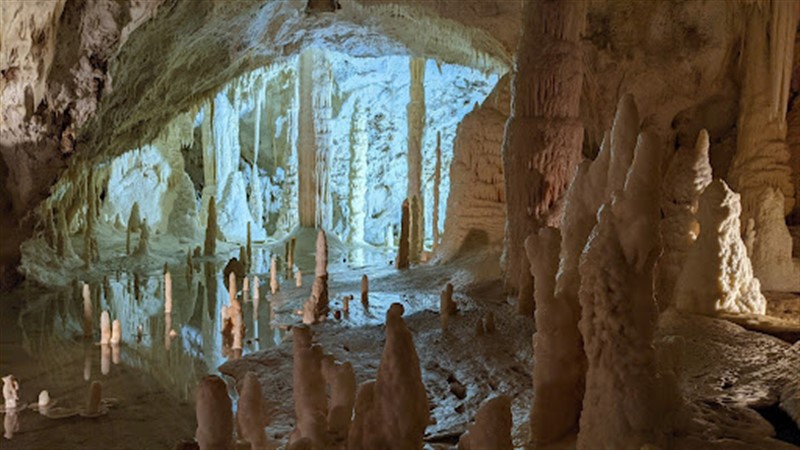Stalactites hang from the ceiling of caves, while stalagmites grow upward from cave floors.
-
 Alanna Madden
Alanna Madden
-
 November 1, 2021
November 1, 2021
-
 Grammar Tips
Grammar Tips
 November 1, 2021
November 1, 2021
 Grammar Tips
Grammar Tips
Stalactites hang from the ceiling of caves, while stalagmites grow upward from cave floors.
There’s a time and place for everything in English grammar, and today our focus is on two geology terms we’re all bound to confuse: stalagmite and stalactite.
The nouns “stalagmite” and “stalactite” are not commonly found outside of scientific articles or travel blogs, and that’s because they tend to reference a type of common speleothems (i.e., cave formations made of secondary mineral deposits).
The key difference between the two formations is that stalactites hang down from cave ceilings with a pointed tip, while stalagmites have more rounded tips that grow up from the floor of caves.
Traditional definitions of the nouns “stalagmite” and “stalactite” reference a common type of speleothem: secondary mineral deposits formed in caves by pooled, sweeping, flowing, or dripping groundwater.
Flowstone, helictites, anthodites, and gypsum flowers are all “types of speleothem” (among many others), but stalagmites and stalactites are perhaps the most exciting speleothems of them all.

Stalactites (named from the Greek word stalagma for ‘a drop’ or ‘a drip’) are hollow, icicle-shaped formations that hang from the roof of caves. The sharp, pointy formations consist of precipitated minerals accumulated from the steadily dripping water.
Stalagmites (named from Greek stalaktos for ‘dripping’ or ‘oozing out in drops’) are the corresponding formation of stalactites that rise from cave floors and point upward. The tips of stalagmites are more convex or flattened than stalactites, often taking a candlestick appearance.
A crucial part of using the words “stalagmite” and “stalactite” is to understand when these structures reference a speleothem or not. Speleothem structures are made from secondary mineral deposits in caves, but not all stalagmites and stalactites are created in caves or from secondary deposits of minerals.
Outside of caves, a “stalagmite” can be any hollow, icicle-shaped structure that hangs suspended, accumulating deposited minerals from some form of dripping liquid. Likewise, a “stalactite” can form in various environments where there’s a continuous dripping of mineral-rich water or a similar deposit of other material.
Speleothems are often made from calcite, aragonite, and gypsum in limestone caves (the chief form of calcium carbonate rock) and can include deposited minerals like opla, chalcedony, and limonite.
Non-speleothem formations can occur on the ceiling of hot springs, basements, mines, within lava tubes, or underneath bridges from a variety of minerals and materials, including concrete, dirt, sand, mud, sinter, peat, pitch, and lava.
Common types of non-speleothem stalactites and stalagmites include:
Stalactite and stalagmite formation occurs in caves from a process called chemical weathering, which is essentially any chemical interaction that erodes or breaks down rock minerals with water.
To create stalactites and stalagmites, cave surfaces must provide a water-soluble mineral or “colloid.” Calcite (calcium carbonate) is the most common deposited mineral from overlying limestone rocks, so we’ll stick to this mineral example.
As water seeps down into caves, it passes through organic matter and acquires carbon dioxide gas, creating carbonic acid. When carbonic acid interacts with cave ceilings, it dissolves calcite (calcium carbonate) from rock surfaces, creating a calcium bicarbonate solution that slowly drips down. After water droplets disperse and evaporate, a deposit of calcium carbonate is left behind.
Stalactites do not form until there’s an initial drop of water hanging through surface tension, meaning the droplet needs to hang there long enough to deposit a solid mineral around its outer rim. As this process continues, the slow drip eventually forms a tube-like channel (like a soda straw), where subsequent droplets accumulate down, depositing minerals around the rim as they fall.
Fun fact: If you remove a stalactite to inspect its inner structure, you’ll find the hollow tube where the initial drip once was surrounded by concentric rings. The rings, much like those of a tree, reflect various periods of growth (rings containing clay suggest periods of no growth).
Stalagmites are solid throughout and typically grow wider and stronger than their stalactite counterparts. Recent studies show stalagmite shapes are dependent on “how far water droplets fall from their stalactite of origin,” meaning the higher the cave ceiling (or distance from stalactite tip), the thicker the stalagmite will be.
Additionally, the faster calcareous water drips onto cave floors, the less controlled calcite precipitation is over a large surface area. Therefore, speedier drip frequencies tend to result in flowstone formation (flat, smoother surfaces), whereas the slowest drip rates result in candle-like stalagmites. Dome and cone shapes fall somewhere in the middle, with dome stalagmites appearing with faster drip rates than cone stalagmites.
When uninterrupted, stalactites and stalagmites form in unison and eventually meet to create one big “column” or “pillar.”
Cave stalactites and stalagmites grow about one inch per year, so large structures take a few hundred years to a million years to grow. The overall growth rate depends on how consistent (and undisturbed) the environment is, with temperature, pH, airflow, and rainwater playing large roles over time.
The most common form of stalactites and stalagmites are found in limestone caves, such as the white chamber of the Jeita Grotto in Lebanon, the Limestone Cave in Yucatan, Mexico, and the Marble Cave in Gadime e Ulët, Kosovo.
Vietnam’s Hang Sơn Đoòng, meaning “cave of the mountain river,” is the largest cave system in the world and contains stalagmites as tall as 70 meters (nearly 230 ft).
As for the world’s longest cave system? That belongs to the Mammoth Caves of Kentucky. The Mammoth Caves are so large–– people describe it as a “labyrinth” with over 400 miles explored and another (possible) 600 miles yet to go.
Tham Sao Hin of Thailand is also remarkable for its pristine towering columns, some reaching near 61 meters (200 ft). However, the largest known stalagmite comes from Cueva San Martín Infierno in Cuba, reaching 67.2 meters long (about 220.5 ft). The world’s largest stalactite reaches 28 meters (about 92 ft) at the Gruta do Janelão in Minas Gerais, Brazil.
Other caves with stalactites and stalagmites around the world include:
Caves with lava stalagmites and stalactites:
Caves with ice stalagmites and stalactites:
Stalactites and stalagmites typically grow in dry caves and away from bodies of water. Few exceptions occur when calcified, such as “The Hells Bells” in the El Zapote cave near Puerto Morelos on the Yucatán Peninsula.
Theoretically, yes. But you shouldn’t. Speleothems are more fragile than they look and, if broken, would require thousands of years to restore to their original state (plus, they are made up of reactive minerals that you don’t want interacting with your skin oils). For these reasons, most of the world’s stalagmites and stalactites are protected by governments as natural heritage objects. So please look, but don’t touch.
There are three easy ways to remember the difference between stalagmites and stalactites:
Use the words “stalactite” and “stalagmite” as singular nouns and “stalactites” and “stalagmites” as plural forms.
Published examples:
Looking for more science-y grammar topics? If so, be sure to check out similar lessons by The Word Counter, such as:
Test how well you understand the difference between stalagmite vs. stalactite with the following multiple-choice questions.
Quiz Answers
*Notes: